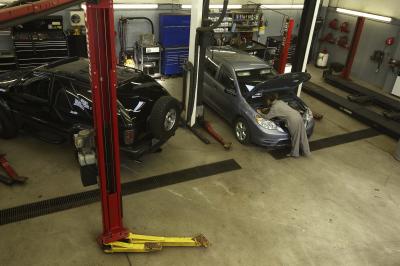
The air induction part of a car's fuel system governs how the gasoline is injected into the engine. These systems deliver the gasoline to the engine cylinders as a mixture of fuel and air, which is usually done with a fuel-injection device or a more old-fashioned carburetor that vaporizes the gasoline and sends it on to the cylinders. In today's cars, computers regulate exactly how much air is mixed with the gasoline to ensure the engine performs efficiently, but residue can still build up, especially in the throttle body.
As the vehicle is driven, the throttle body, fuel injection system and air intake parts can all fall victim to a process known as carbonization. This is a build-up of residue that occurs when fuel is vaporized and then ignited in the engine's cylinders. The heat the engine creates while running will literally bake some of the heavier fuel residue onto the pipes and surfaces of the throttle body and fuel injection system.
Contaminants also come in the air and become attached to the residue. They in turn are also baked in, and the carbonization continues layer by layer. This causes a number of engine problems over time, including rough idling, hesitations and surging in engine performance, poor gas mileage, dirtier emissions and annoying knocking or pinging noises. These problems develop more easily with low-grade gasoline or an older, less efficient engine.
Carbon is notoriously difficult to remove from the surfaces it has been baked on, so mechanics and manufacturers have developed powerful methods to clean air induction systems. There are several different ways to do this. Older and more thorough ways take apart the fuel injection system and clean it piece by piece, removing all deposits or replacing pieces before putting them back together. Newer methods use compressed air systems to send cleaners into different parts of the fuel injection system without taking it apart, lowering the cost and time require to clean the throttle body.
Either way, powerful cleaning agents are used to remove the carbon deposits, usually highly acidic compounds that are able to dissolve the carbon and carry it away. The goal is to balance the cleaning power with keeping the throttle and injection seals whole and functioning. Several stages are often used, with lighter cleaners used afterward to wipe away any remaining residue and traces of induction cleaners. Some companies sell both injection apparatus that use an included source of clean air to blast cleaners through a fuel injection system, and powderized cleaners that combine solvent and degreasing properties.